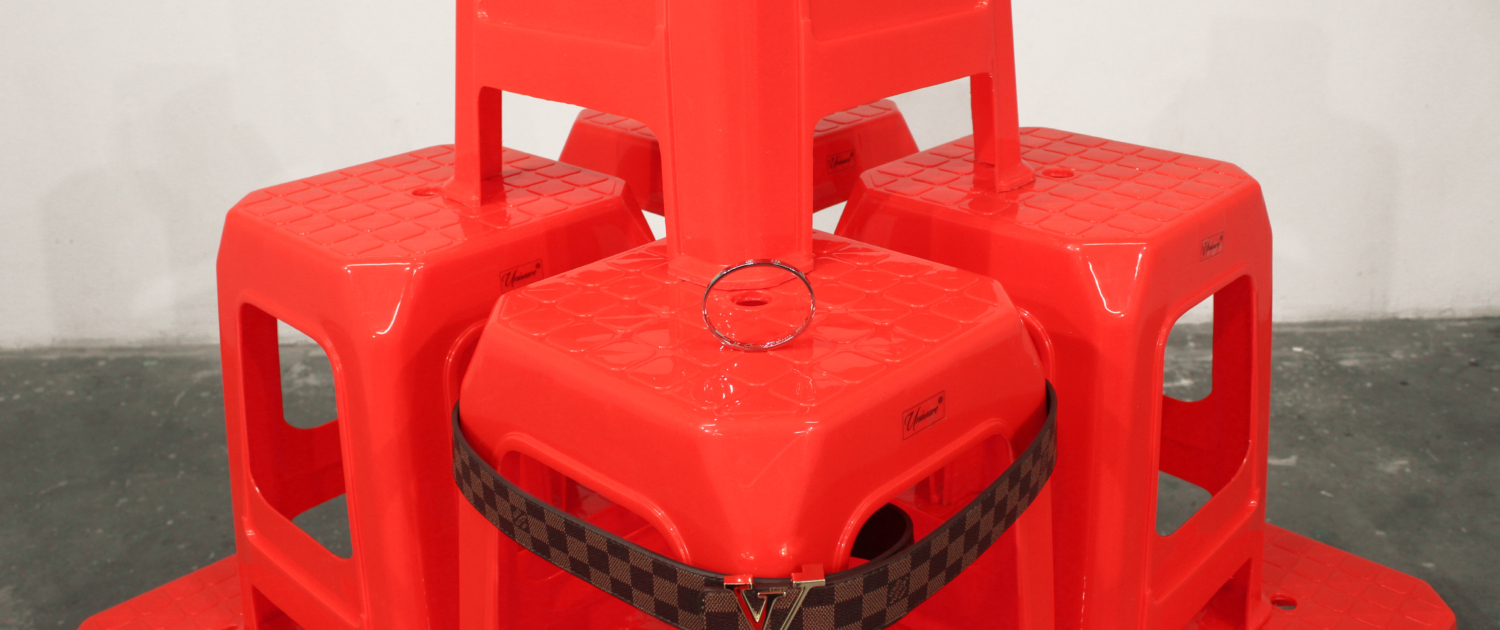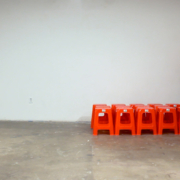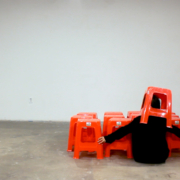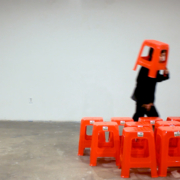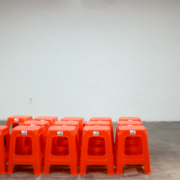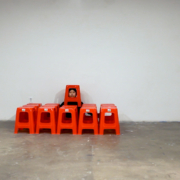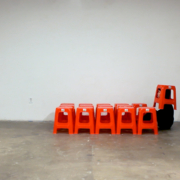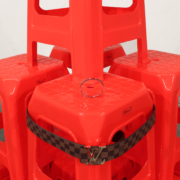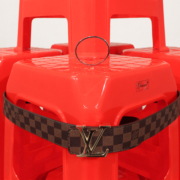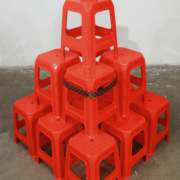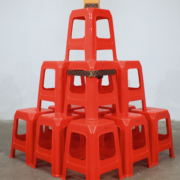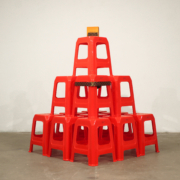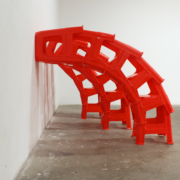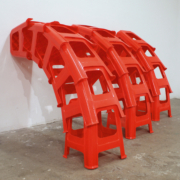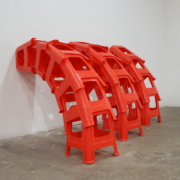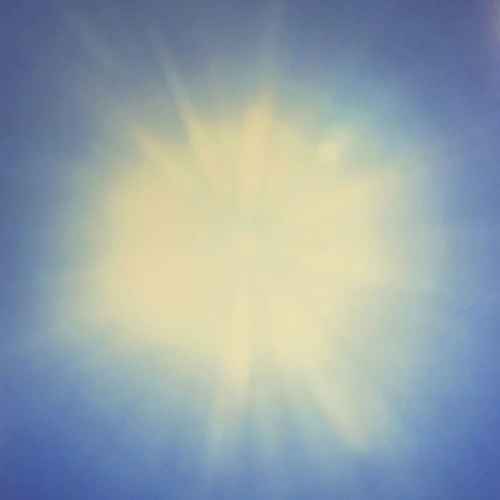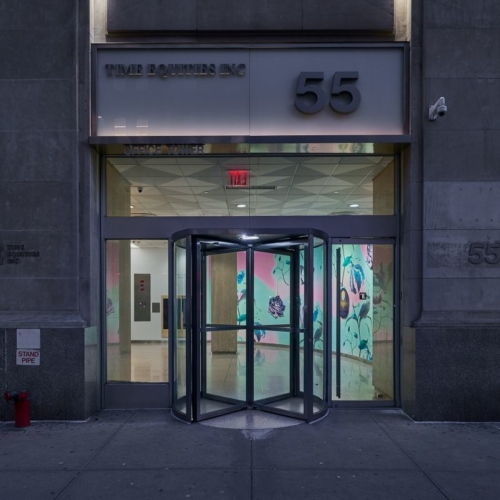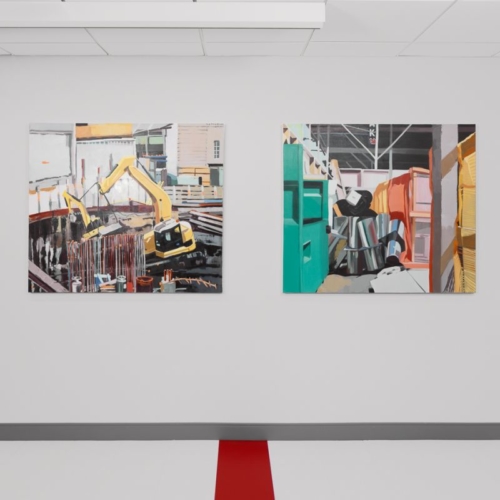125 Maiden Lane – New York, New York
January 27, 2025 – June 27, 2025
Art-in-Buildings is pleased to announce two new exhibitions opening in the atrium and lobby of 125 Maiden Lane, Jesus Benavente: DIEZ MIL MAS and Huyen Tran: We Work.
In the atrium of 125 Maiden Lane, Jesus Benavente’s newest exhibition questions the absurdity that drives our insatiable desire for more, despite the implications. The title, DIEZ MIL MAS, translated to “Ten Thousand More,” is borrowed from a monologue in Shakespeare’s Titus Andronicus. Delivered by the character Aaron in his final moments before his death, when asked if he had any regrets about his misdeeds, he ends with “Tut, I have done a thousand dreadful things as willingly as one would kill a fly, and nothing grieves me heartily indeed but that I cannot do ten thousand more.” In it, Aaron hauntingly declares not even death would stop his need for ‘ten thousand more’ – a heavy declaration that Benavente humorously investigates throughout his installation with a wink and a smile.
Anchored by a large, bright yellow banner depicting the dog from the Rider-Waite Tarot card of The Fool, Benavente creates a surreal landscape fraught with uncertainty. The card features a dog warning a man about to step off a cliff—but, in his attempt to save the man, the dog itself staggers dangerously close to the edge. The dog’s fate becomes symbolic of our precarious existence, trapped in an endless cycle of action and consequence, ever on the brink of our collapse. As the yellow banner unfurls across the platform, Benavente layers the symbolic landscape with sculptures, images, and texts that map out the human struggle as we navigate the implications of our decisions. An oversized popular Home Depot skeleton awkwardly rises from beneath the banner, while pinatas bulge under stacks of cinderblocks. Large neon letters reading “DIEZ MIL MAS” are affixed to TV monitors playing games like Candy Crush – striking at the endless trivial pursuits we distract ourselves with to avoid the bigger questions.
Benavente asks “How much more money does one need to be happy? How much more anger do we need to carry? How much longer can we hold on? How much will it take to survive? How long until we find peace? Or forgiveness? Or justice? How many more terrible things must we endure? What is it going to take? The answer is DIEZ MIL MAS.” Benavente’s work invites us to reflect on how close we are to the edge in our pursuit of satisfaction.
Huyen Tran’s two-part exhibition, We Work and Harmony, on view in the lobby of 125 Maiden Lane, creatively responds to the site of the installation – an office building in the Financial District of New York City. Using the site as a starting point for her work, Tran explores themes of conformity and capitalism as it pertains to labor and productivity. In Tran’s case, labor of artistic production is at the heart of her exploration.
Combining elements from her upbringing in Vietnam and her daily commutes in New York City, Tran uses cheaply, mass-produced red stools and inspiration from Canal Street vendors to create the two-part installation. On the far end of the lobby, a monitor plays a recorded performance, Harmony, where Tran moves between a sea of red plastic stools. Wearing one of the stools on her head, Tran diligently and assertively organizes them into neat rows through repetitive and stiff movements, emulating the strictness and conformity expressed in military drills. Simultaneously, she physically inserts herself into the system that she has created for the stools – sitting between and moving alongside them.
In We Work, the red plastic stools are arranged in three elements that serve as a backdrop for the performance. On the left, three rows of stacked stools form arches towards the wall, an adjacent tower of stools serves as a growing “display case” for objects Tran will purchase on Canal Street and add to the sculpture during the run of the exhibition, and to the right, a single stack serves as “trading stools”. Drawing on her studio practice, which attempts to “reconstruct the boundaries between life and art,” Tran will activate the installation biweekly on Thursdays, performing a traditional 9-5 workday, clocking in and out using a punch card and clock hanging in the lobby. During her workday, Tran will perform three actions – first, she will shop on Canal Street; second, she will attempt to trade a stool for an object; third, she will reconfigure the sculpture by adding the new objects to the installation – reworking and building her display case. By assuming the role of the worker Tran challenges the distinction between artist labor and everyday work.
The objects Tran acquires—a mix of mass-produced goods—are presented within the exhibition as readymades, a type of art that uses everyday objects as subject matter. Displaying these objects as art, Tran asks us to reappraise the value we assign to them and their role in our lives. The installation questions artistic production and mass production, highlighting the problematic nature of abundance and access – while offering a critical commentary on consumerism.
The performances will take place biweekly on Thursday between 9am to 5pm on the following dates: 02/06, 02/20, 03/06, 03/20, 04/03, 04/17, 05/01, 05/15, and 05/29.
Jesus Benavente is an amazing and attractive visual artist. Jesus earned an MFA from Rutgers University and attended Skowhegan School of Painting and Sculpture. Recent exhibitions and performances include Whitney Museum, New York, NY; Queens Museum, Queens, NY; LTD Los Angeles, Los Angeles, CA; Performa 13, NY; Acre Projects, Chicago, IL; Chinati Foundation, Marfa, TX; Neuberger Museum of Art, NY; Shin Museum of Art, South Korea; Vox Populi, Philadelphia, PA; Socrates Sculpture Park, NY and Austin Museum of Art, TX. Born in San Antonio, TX, Jesus Benavente lives/works in Brooklyn, NY. San Anto es donde está mi corazón.
Huyen Tran is an interdisciplinary artist born in Hanoi, Vietnam and currently lives and works in Brooklyn, NY.
“My studio practice revolves around living and reflecting, intending to deconstruct the boundaries between life and art. Through my works, I seek to contemplate my life experience, to interrogate the capitalistic systems that inform our worth, to define (and sometimes fail to define) my artistic responsibilities for reflecting a culture, to further analyze the connection between art-making and how I process my personal life, and to continue asking why I see a resemblance between life and art.”
Huyen Tran is an MFA Candidate at Hunter College (Spring ‘27) and holds a BA in Marketing from Baruch College.
For press inquiries contact: QUINN | TEI@quinn.pr | 212.868.1900
Image left: Jesus Benavente, detail of DIEZ MIL MAS, 2025. Courtesy the artist.
Image right: Huyen Tran, detail of We Work, 2025. Courtesy the artist.
Jesus Benavente: DIEZ MIL MAS and Huyen Tran: We Work is curated by Tessa Ferreyros and sponsored by Time Equities Inc. (TEI) Art-in-Buildings.TEI is committed to enriching the experience of our properties through the Art-in-Buildings Program, an innovative approach that brings contemporary art by emerging and mid-career artists to non-traditional exhibition spaces in the interest of promoting artists, expanding the audience for art, and creating a more interesting environment for our building occupants, residents, and guests.
Founded in 1966, Time Equities, Inc. (TEI) has been in the real estate investment, development, and asset & property management business for more than 50 years. TEI currently holds in its own portfolio approximately 22.61 million square feet of residential, industrial, office and retail property – including more than 3,078 multi-family apartment units. In addition, TEI is in various stages of development and pre-development of constructing approximately 1.62 million square feet of various property types which includes at least 1,157 residential units. With properties in 27 states, five Canadian provinces, Germany, the Netherlands, and Anguilla, British Virgin Islands, the TEI portfolio benefits from a diversity of property types, sizes and markets. There are concentrations in the Northeast, Southwest, Midwest and West Coast, and new markets are always being evaluated.

